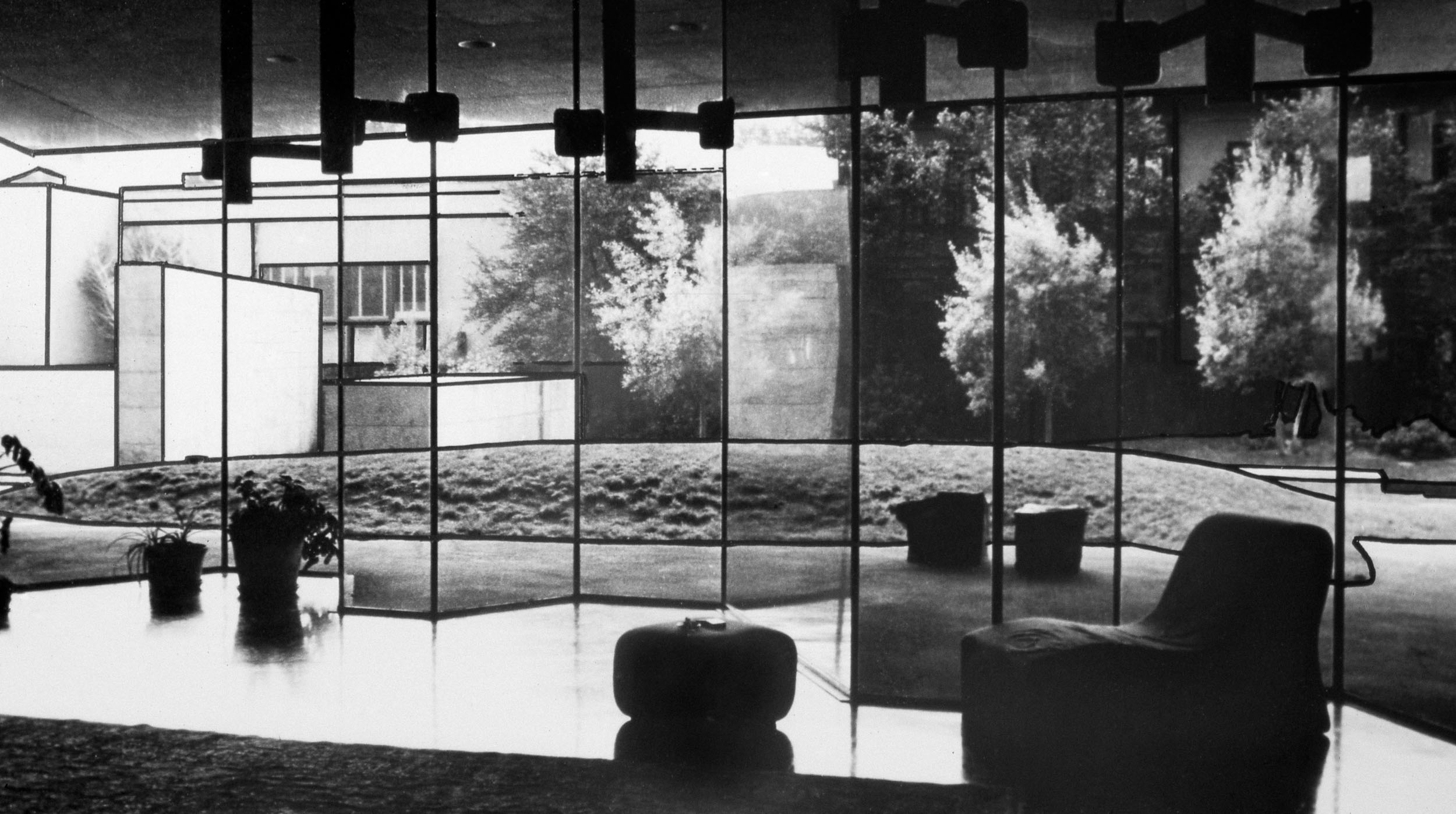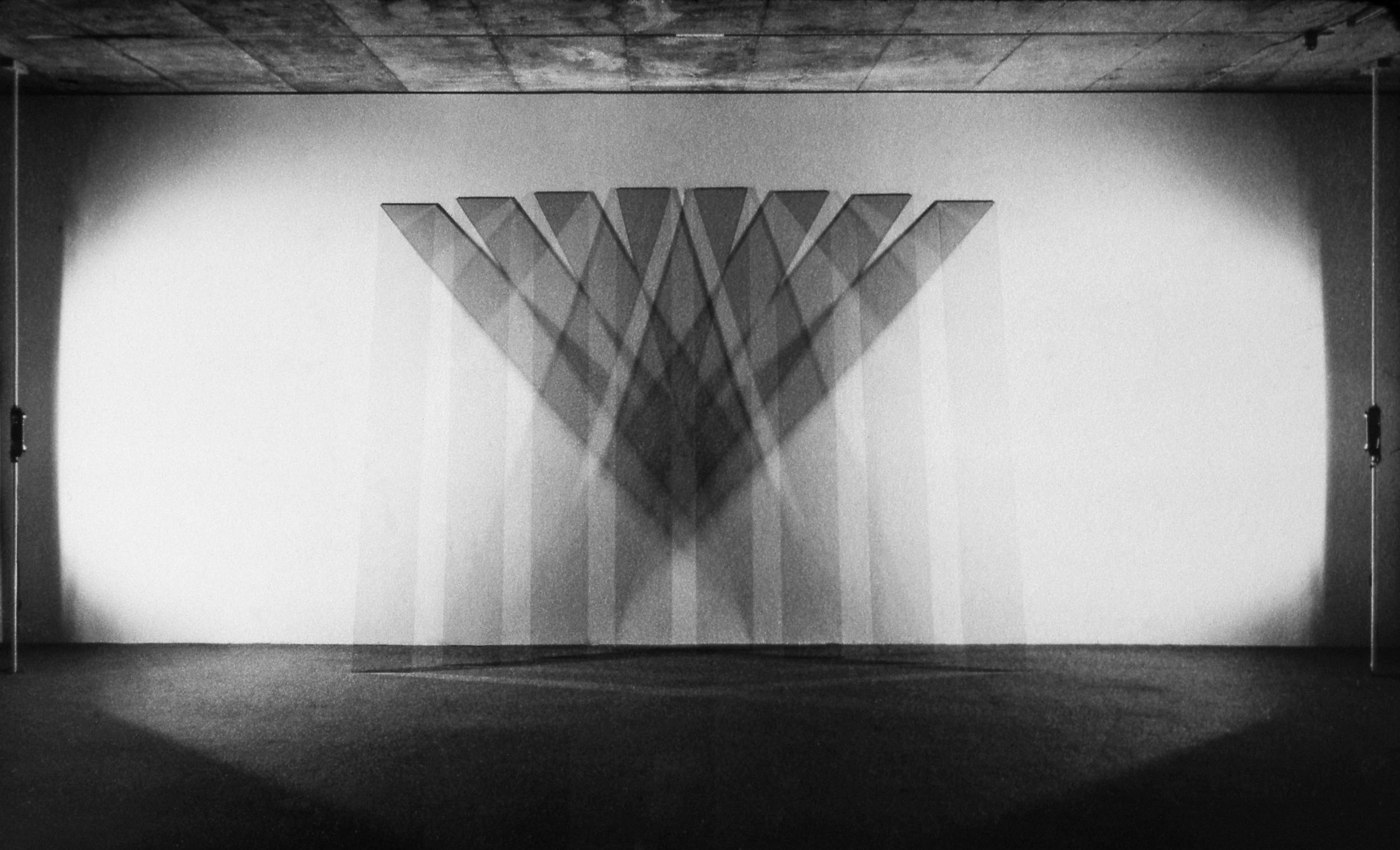








Your Custom Text Here
Shoji paper and bamboo frame
4’H x 6’D x 6’W
Installed at Sakaimachi Garow*
(*Possibly “Garreri”)
Water pool 6'W x 60'L x 6"D and 2 quartz lights
Installed at Museum of Contemporary Art, Chicago, Illinois
Water pool 20'W x 30'L x 6"D
Installed at 80 Langton Street, San Francisco, California
View toward entrance
Live video installation, image approximately 10'H x 8'W
Installed at Wilshire West Plaza, Los Angeles, California
3 panels, one of plate glass, one of plate glass backed with mirror, one of mirror backed with mirror, 4'H x 4'W x 1/4"D each
Installed at MoMA P.S. 1, Long Island City, New York
View toward southwest
10 plate glass mirrors 4'H x 1'W x 1/4"D each, 9 plate glass panels 4'H x 1'W x 1/4"D each, and chart tapes
Installed at the Gagosian Gallery, Los Angeles California
View with one set of tape lines aligned with reflection of perimeter on floor
View with tape lines out of alignment
View from side
Mixed media environment
Installed at Baxter Art Gallery, California Institute of Technology, Pasadena, California
Trapezoidal light projection on left, painted parallelogram on right
Gallery windows and black tape
Installed at University Art Museum, Berkeley, California
View in alignment
View out of alignment
8 glass panels 8'H x 1'W x 1/4"D each and 2 quartz lights
Installed at the University Art Museum, Berkeley, California
On left, Spatial Topography, 1978, 70 gelatin silver prints
Virtually all of Zimmerman’s works treat form as a function of a spectator’s position in the surrounding space that gives the form its definition. Her work has frequently been conceived as a sequence of integrated spatial experiences, as architecture is. For the most part, Zimmerman’s works develop in response to given materials, situations, or settings, and it is her acute attentiveness to them that gives her art its unique character.
The Light and Space Art Movement originated in 1960s Los Angeles and introduced Zimmerman to what was regarded as a pioneering attitude that holds art as a function of human perceptual systems. As Robert Irwin put it, “The subject of art is aesthetic perception.”
Light and Space artists dismissed narrative and decorative pictorial traditions and turned instead towards simple, self-contained environments in which a viewer/participant could be insulated from the distractions of the outside world. Such environmental works often seem designed to promote meditation, insofar as they are intended to engage a spectator’s self-awareness of the complexities and paradoxes of the act of perception itself.
Zimmerman often uses mirror surfaces in her works (1977, P.S.1; 1976, Broxton Gallery). As a result, spectators encounter images in direct conjunction with what they represent. The mirror elements in her works “contain” images of the physical surroundings in which they themselves are contained—one reality appearing to overlay another.
Zimmerman’s works frequently make spectators conscious of continuities between direct experience and experience transmitted through image. This was the case with a piece entitled Displacement, executed in Los Angeles in 1978 in a 2-story space with tall clerestory windows through which passersby outside at ground level were visible. Since she masked off the middle section of the window area, a spectator inside observed the changing scene outside as it came into view, then passed out of view, and returned again. The blocked-out frame in the sequence was picked up on a closed-circuit video system and screened life-size inside, directly underneath the masked window. The image of what passed out of view outside came into view inside—displaced.
At the U.S. Custom House in New York in 1979 she installed a full-scale painting on the wall that blocked off one of the building’s corridors. The photographically detailed painting represented the masked-off corridor. Her painting installed here marked a reality that in fact existed where one perceived it, although it was hidden from sight.
At 80 Langton Street in San Francisco in 1979 she constructed a shallow pool, which acted as a dark mirror in which ceiling, walls, and pillars were reflected—thus doubling the apparent scale of the darkened room (Black Pool I, 1978). This illusion expanded and transformed the dim, utilitarian space, into a visual experience of Piranesian complexity.
Later that year, Zimmerman reformulated this dark reflecting pool concept for an exhibition at Chicago’s Museum of Contemporary Art (Black Pool II, 1978). She constructed a shallow fiberglass pool along the room’s long axis upon which the pillar was situated. The pillar seemed to rise up from the water into the darkened room that was illuminated by two overhead spotlights aimed at the pillar’s opposite sides. “I know I sound rapt,” wrote Joanna Frueh in Artforum, “but Zimmerman’s piece, like a secret chamber or a consecrated spot, encourages imagination, reflection, and enlightenment.”
Edited excerpt of essay by Charles F. Stuckey in Palisades Project/Elyn Zimmerman, Published by The Hudson River Museum, 1982